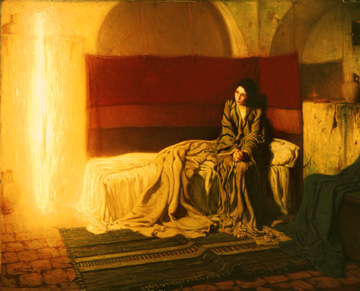The two paintings look vaguely similar, as they should. The larger is well known and often reproduced. It is Henry Ossawa Tanner’s L’Annunciation, painted in 1898. In it Mary, who is neither blond-haired or blue- eyed, is listening gravely and intently as the Angel Gabriel tells her of her sublime destiny to be the Mother of God. The angel is represented by a shaft of pure light. The picture can usually be viewed at the Philadelphia Museum of Art.
The second, which is smaller, La Sainte-Marie, was painted in the same year; but in this, the Blessed Virgin has an expression of consternation and sorrow. One has to look closely to realize it is really a Madonna and Child. The Child is represented by a shrouded bundle at her feet, identifiable only by a halo over the Child’s unseen head. Also, the hem of Mary’s garment is stained with what appears to be blood. The general interpretation is this takes place after Simeon’s prophesy to Mary of the sorrow that would pierce her heart, because of her Son’s suffering. This also normally hangs in the Philadelphia area but at Olney’s hidden gem, the Museum of La Salle University.
Both are part of the Pennsylvania Academy of the Fine Arts (PAFA) retrospective,
which is running Jan. 28-April 15.
Tanner (1859-1937) studied at the Academy under Thomas Eakins and Thomas Hovington 1879-1885, and went on to become the first African American artist to receive international recognition. He was also the foremost American painter of religious subjects of his era.
The exhibit which contains more than 100 of Tanner’s works include 12 paintings that have never been shown in a Tanner retrospective and his Resurrection of Lazarus, for the Musee D’Orsay, the painting that gave him his first critical acclaim and which has never been seen in America before.
[hotblock]
Tanner was born in Pittsburgh but raised mostly in Philadelphia where his father, Benjamin Tanner was a minister at Mother Bethel Church and eventually a bishop of the African Methodist Episcopal Church.
At PAFA, which had a history of admitting black students, he did encounter some racism from his fellow students but also criticism from some local blacks for associating with whites.
After trying to make his way in Atlanta with a photography studio and art teaching, he relocated to Paris, the art capital of the world, where he continued his studies, and submitted his works to various exhibits, including the prestigious Paris Salon, where his Daniel in the Lions’ Den received an honorable mention. This work, which is sadly lost and only exists in photographs, hearkens back to his Philadelphia days when he would paint lions at the Philadelphia Zoo. Even an honorable mention at the Paris Salon was a big thing, and to further his talent Philadelphia’s Rodman Wanamaker paid his expenses for a journey to the Middle East where he could get a better understanding of the culture.
What must have most gratified Tanner was that in Paris he was identified as an American artist, not a “Negro” artist as was the case in America. He stayed in France for the rest of his life, making only brief visits home to the family or for exhibitions from time to time. In 1897 when The Resurrection of Lazarus received a medal at the Paris Salon, it was automatically purchased by the French government and he earned the right to exhibit at the Salon every year.
“Tanner used the features of the people of the Holy Land,” said Anna Marley, curator of Historical American Art at PAFA. “Like Rembrandt he was interested in getting back to the people of the Holy Land. But other painters at the Salon were not doing that. He was thinking about the Jewishness or Semitic nature of Christ.”
So far the retrospective has been well received and it is Marley’s dream that some of the lost paintings, known only by photographs sent to PAFA by Tanner, might be rediscovered perhaps stored away in the basements of churches that do not know the treasures they have.
Most of Tanner’s works prior to his Salon period were not religious in nature, and as a matter of fact a Tanner beachscape hangs in the White House. His focus on the religious genre during his Salon period may well be because that’s what was successful and what his clients expected of him. But he was clearly a spiritual man, and it shines though his art. Like most artists who trained at PAFA, his style was realism and that is where he was most successful. “He liked Matisse as a man, but did not consider his work art,” Marley said. This realism is less evident in his later works when he began to experiment with different pigmentations.
No less than 52 institutions and private collectors contributed to Henry Ossawa Tanner: Modern Spirit, probably the most ambitious retrospective on Tanner ever assembled. After its run at PAFA it will travel on to Cincinnati and Houston.
La Salle University will have to wait a full year before La Ste. Marie is back on their wall. “It was a hard decision to let it go,” said Klare Scarborough, director and chief curator at La Salle, who nevertheless considers the PAFA exhibit excellent.
For more information see www.pafa.org





Thank you for noting that Tanner “received criticism from some local blacks for associating with whites” most especially his association with the model he used for Christ’s mother Mary who was in fact his own white wife. ~ M. Morrow-Farrell (former Museum Assistant, La Salle Univ. Art Museum)